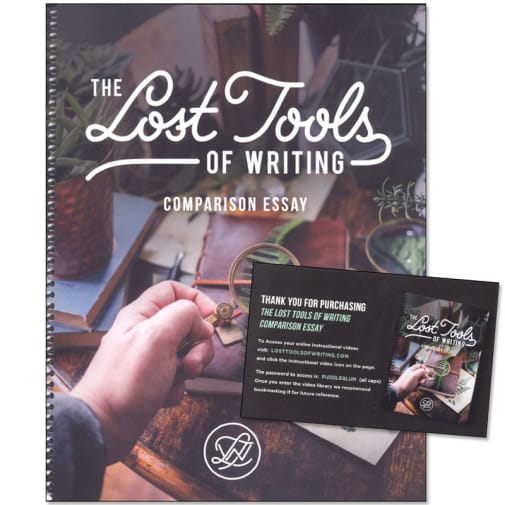Lost Tools of Writing - Comparison Essay Complete Set
Product Overview
- Recommended for students who have completed Lost Tools of Writing Level One
- One-semester course that teaches comparison outlines and essays
- Set includes all-in-one student/teacher book and instructional videos
Description
The Comparison Essays Complete Set includes a LTW Comparison Essay Guide and Online Instructional Videos. All-in-one combination Student Workbook/Teacher Guide LTW: Comparison Essays does not have a separate teacher guide. Codes to access the online instructional videos will be sent via email.
Welcome to The Lost Tools of Writing: Comparison Essay. This semester-long program provides a way for students to gain more practice in foundational thinking skills plus practice in writing a different kind of essay. Through LTW: Comparison Essays, students will solidify the foundations laid in LTW I, develop deeper thinking skills, master an additional form of essay-writing, and delve more deeply into analogical thinking with different kinds of metaphor-writing. The skills students gain through LTW: Comparison Essay extend beyond academics to life in the world, cultivating more refined and careful thinking about people, things, ideas, and their own decisions.
LTW: Comparison Essays fulfills the purpose of understanding people, things, or ideas more deeply, or assessing whether one is better or in some way more desirable than another. The bigger purpose of these thinking and writing skills is to grow in wisdom and prudence by practicing making finer distinctions and better decisions. Students can learn and practice principles and habits of decision-making for their own lives.
Lost Tools of Writing provides a thorough breakdown of skills, tools, and basic principles to learn and use in the step-by-step process of developing the art of communication. Aiming at “creative discipline” as well as “disciplined creativity,” three canons (or principles) are explained: invention (ideas), arrangement (ordering of ideas), and elocution (expression of ideas). Once explained, these canons are then incorporated into lesson exercises and assignments. Lessons are covered over several weeks while the student constructs an essay/address. Teacher-Student interaction is essential. Teacher contributions include concept presentation and development as well as discussion. Thankfully, the support for the teacher is impressive. There are instructional videos for the teacher (lifetime access available free from the publisher’s website for the purchaser), thoroughly developed lesson plans, and extensive samples. Lost Tools of Writing is a robust, systematic course that prepares students to think and to communicate ideas well.
Required for each level are the Teacher Guide and Student Workbook. These are available separately or in a Set. Purchase of the Set also includes the link and password to instructional videos at the publisher website.
The Teacher Guide for each level is the teacher's companion and foundation. It provides a thorough explanation and introduction to classical writing and to the way it is developed in the Lost Tools. It also includes a proposed Plan of Action, a Year-at-a-Glance Chart, a Lesson Sequence, and the comprehensive Lesson Plans with samples and worksheets. An impressive set of Appendices are also included.
The Student Workbook provides worksheets for the lesson exercises, essay templates, and appendices (Self-Edit Checklists, Sample Essays, Glossary, and Lesson Summaries). The student uses this to complete the preparatory assignments leading up to the crafting of each lesson's essay assignment. One Student Workbook (not reproducible) needed per student. Available only in the Teacher/Student Set is a link and password to access helpful instructional videos from the publisher’s site. Instructional videos provide parents additional tips and insights for teaching through the Lost Tools of Writing Level.
| Product Format: | Other |
|---|---|
| Grades: | 9-12 |
| Brand: | Circe Institute |

